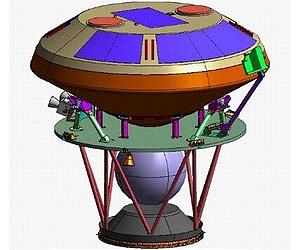by Henry Bortman
for Astrobiology Magazine
Moffett Field CA (SPX) Mar 19, 2010
New discoveries have a way of messing with old definitions. Take, for example, the concept of a habitable world.
The standard definition of a "habitable world" is a world with liquid water at its surface; the "habitable zone" around a star is defined as that Goldilocks region - not too hot, not too cold - where a watery planet or moon can exist.
And then there's Titan. Saturn's giant moon Titan lies about as far from the standard definition of habitable as one can get. The temperature at its surface hovers around 94 degrees Kelvin (minus 179 C, or minus 290 F). At that temperature, water is a rock as hard as granite.
And yet many scientists now believe life may have found a way to take hold on Titan. Water may all be frozen solid, but methane and ethane are liquids. In the past few years, instruments on NASA's Cassini spacecraft and images captured by ESA's Huygens probe have revealed an astonishing world with a complete liquid cycle, much like the hydrologic cycle on Earth, but based on methane and ethane rather than on water.
<snip>
The chance to discover a form of life with a different chemical basis than life on Earth has led some researchers to consider Titan the most important world on which to search for extraterrestrial life.
In a recent paper in the journal Astrobiology, Robert Shapiro, a professor of chemistry at New York University, and Dirk Shulze-Makuch of Washington State University rated Titan a higher-priority target for investigation than even Mars. An engineering drawing of the proposed Titan Mare Explorer (TiME), sitting atop its carrier spacecraft. TiME would land in one of Titan's northern lakes and drift across its surface, taking photographs and analyzing the lake's chemistry. Credit: Lockheed Martin
An engineering drawing of the proposed Titan Mare Explorer (TiME), sitting atop its carrier spacecraft. TiME would land in one of Titan's northern lakes and drift across its surface, taking photographs and analyzing the lake's chemistry. Credit: Lockheed MartinMore:
http://www.spacedaily.com/reports/Life_Without_Water_And_The_Habitable_Zone_999.htmlHat-tip to:
http://twitter.com/SETIInstitute/status/10889963714